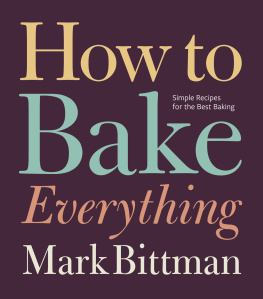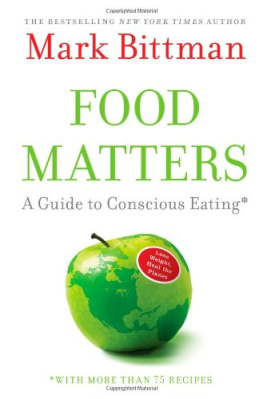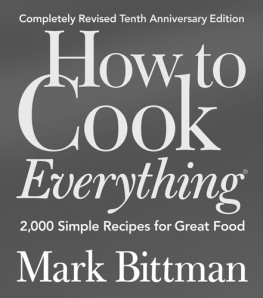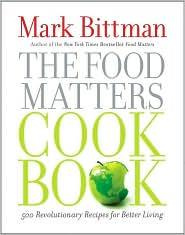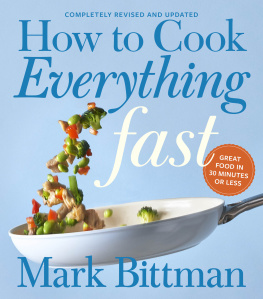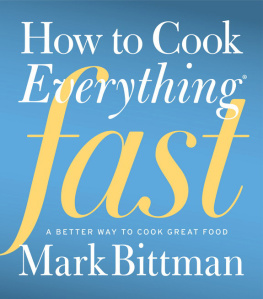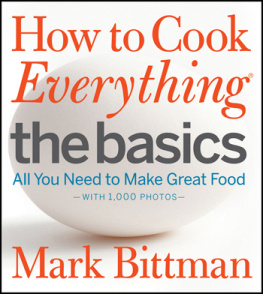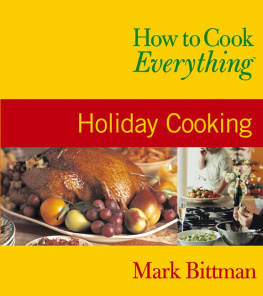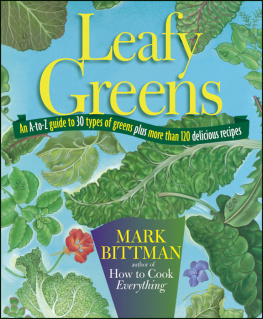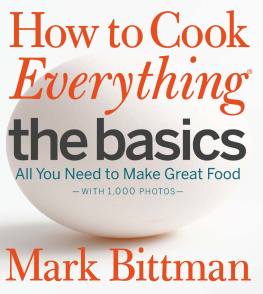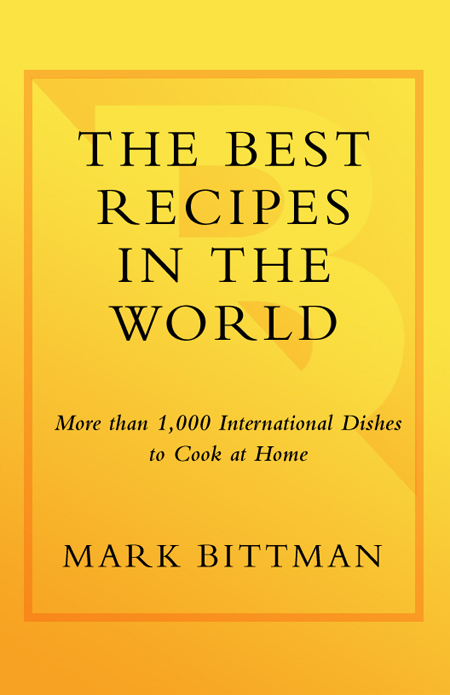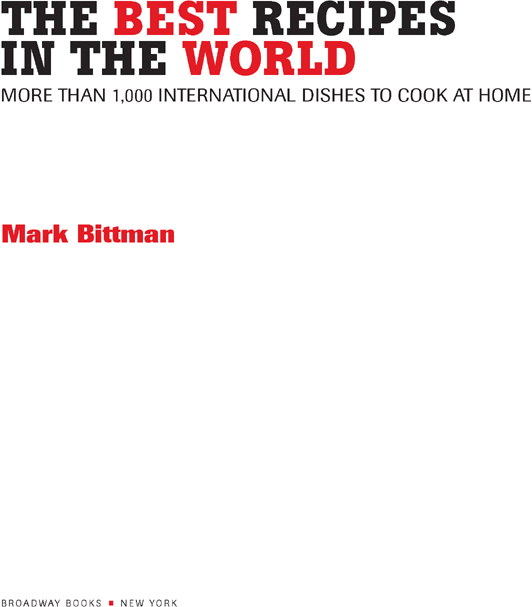ACKNOWLEDGMENTS
I dreamed about writing an international cookbook for thirty years, and I'm grateful to everyone who allowed me to convert my fantasies into reality It's literally impossible, however, for me to mention everyone who helped me, kind cooks worldwide who invited me into their homes and shared their skills, their warmth, and their families' food. How similar we all are when cooking and eating never ceases to amaze me.
I had plenty of help at home, too. Genevieve Ko Sweet worked hard and long in helping me determine the ultimate versions of the recipes you see here; Kate Bittman and Peter Mee-han also played key roles in getting the manuscript into shape.
At Broadway Books, my editor, Jennifer Josephy, managed the project (and me) in stunningly efficient fashion. Copy editor Chris Benton caught more gaffes than I care to admit, smoothed my not-always-brilliant prose, and helped me reorganize the book into the (I hope user-friendly) shape in which you see it. I'm happy to count Doubleday/Broadway publisher and president Steve Rubin among my friends, and I remain grateful for his professionalism as well.
The other staff at Broadway Books were also terrific. I worked most closely with Elena Park, Ada Yonenaka, Elizabeth Rendfleisch, Luisa Francavilla, Catherine Pollock, and Nicole Dewey. Many othersoutstanding professionals allworked hard on this massive project.
Some of the ideas that were spawned by this book found a home in stories that ran in the New York Times, where I happily work with Kathleen McElroy and Nick Fox. Pat Gurosky and Kris Ensminger have been terrific colleagues for years, and Barbara Graustark is inspiring, understanding, and supportive. Sam Sifton was my editor during much of the period I was working on this book, and there is no better. Other people to whom I will remain thankful forever are Linda Giuca, Louise Kennedy, Trish Hall, Rick Flaste, and Chris Kimball. My debt to Jean-Georges Vongerichten is equally enormous, though the rumors that he taught me how to cook are unfounded.
There was a period of researching this booka rather intense five or six yearsthat was especially challenging. I relied heavily on the support of many, many relatives and dear friends: Karen Baar, John Ringwald, David Paskin, Pamela Hart, Sherry Slade, Fred Zolna, Semeon Tsalbins, Bob and Mary Newhouse, Shari and Harry Sucheki, Joe and Kim McGrath, Jack Hitt, and Lisa Sanders. Special mention: the Baldinos, for being ideal neighbors.
To Angela Miller, Charlie Pinsky and John H. Willoughby people who are there for me every day my love and thanks. To Alisa X. Smith, who spent more time with me (and this book) than anyone else, I add my eternal gratitude. And to my parents, Murray and Gertrude, and my kids, Emma and KateI just consider myself lucky. xxx guys.
CONTENTS
Introduction
Home cooking has never been easier, more exciting, or filled with as much potential. A mere generation agoin many parts of the country a mere ten years agoif you wanted soy sauce or miso, you went to an Asian market; if you wanted decent olive oil or mozzarella, you went to an Italian market; and if you wanted bulgur or phyllo, you went to a Middle Eastern market. Now all those ingredients, and many more, are routinely available at supermarkets throughout North America. Creating a well-stocked international pantry may still require some time and workyour supermarket may not carry miso, curry paste, or chipotles (though many do)but lots of formerly exotic items are widely available. And the international pantrywhich requires only occasional replenishmentenables the home cook to vary his or her cuisine with almost no work.
Every bit as important as ingredients, however, is knowledge: what do we do with this miso, these chipotles, this curry paste? Here again we're in luck. More information about the cooking of other lands is available than ever before, and the planet becomes smaller every year. With or without this cookbook, if you had never cooked Vietnamese food before and wanted to do so tonight, you could dig up a few recipes, head over to the supermarket, spend a couple of hours in the kitchen, and be wolfing down that caramelized shrimp before dark.
So. We have the ingredients and we have the knowledge. My goal in this book is to help you become familiar with the ingredients, to distill the knowledge, and to make the recipes as accessible as possible and as American as I can, without robbing them of their souls.
THE TECHNIQUES OF INTERNATIONAL COOKING
This is not as challenging as it sounds. In my other boldly titled book, How to Cook Everything, I focused on the techniques of basic cooking. I recognized that there was a crying need for a book that covered the basicsone written primarily for the couple of generations of cooks that we had lost to so-called fast and convenience foods, to the lure of restaurants, to lack of interest and the family of two wage earners. (In fact, there are a dozen reasons why many Americans began to stop cooking in the fifties and sixties and have only recently resumed or taken it up for the first time.)
But the voyages I took for this book convinced me of something I'd already known: ingredients change, but technique does not. It's all basic. I have traveled consistently for three decades, always with food as the focus, but beginning in 1999 I began to travel internationally with increasing frequency, with the aim of making the recipes included in this book as authentic as possible at home. As I said, my trips confirmed that cooking techniques simply don't vary from one place to the next.
At least not much. Some techniques, of course, are unique to a given culture, and others are tweaked from one culture to the next. One might wrap food in banana leaves before steaming; another might use corn husks or paper (or, for that matter, aluminum foil)but this hardly makes a difference. In the broad scheme of things, for home cooks who are not looking to become expert at any given cuisine, these differences are irrelevant. It turns out that the techniques of cookingapplying heat to food with the goal of making it more digestible, palatable, and, ultimately, deliciousare pretty much the same wherever you go. (Think about it; how many ways can you actually cook?) It's the flavors that change.
The world's cuisines have far more in common than not. Think about bits of food wrapped in pastry and baked, fried, or steamed. You might call them dumplings, pot stickers, ravioli, or empanadas, gyoza, manti, or pierogi (I could go on). They're universal. I recently held a dumpling up in front of a class of students at a local community college, where the ethnic groups were as diverse as they are at the JFK International Arrivals Terminal. I asked whether anyone came from a country where such a thing didn't exist. No hands were raised. The differences are more about whether you season them with parsley and Parmesan or garlic and soy sauce and ginger than about how you put them together.


